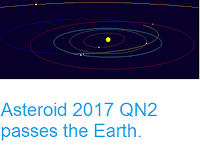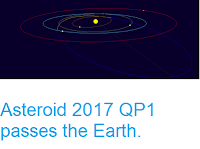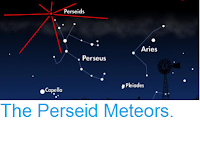Asteroid 2017 QT1 passed by the Earth at a distance of about 995 600
km (2.60 times the average distance between the Earth and the Moon, or 0.67% of the distance between the Earth and the Sun), slightly before 6.25 pm
GMT on Monday 22 August 2017. There was no danger of
the asteroid hitting us, though were it to do so it would have
presented a significant threat. 2017 QT1 has an estimated
equivalent
diameter of 8-27 m (i.e. it is estimated that a spherical object
with
the same volume would be 8-27 m in diameter), and an object of this size would be expected to explode in
an airburst (an explosion caused by superheating from friction with the
Earth's atmosphere, which is greater than that caused by simply
falling, due to the orbital momentum of the asteroid) in the atmosphere
between 35 and 18 km above the ground, with only fragmentary material
reaching the Earth's surface.
The calculated orbit of 2017 QT1 Minor Planet
2017 QT1 was discovered on 17 August 2017 (five days before its closest approach to the Earth) by the University of Hawaii's PANSTARRS
telescope on Mount Haleakala on Maui. The designation 2017 QT1 implies
that it was the 44th asteroid (asteroid T1) discovered in the second
half of August 2017 (period 2017 Q).
2017
QT1 has a 1453 day orbital period and an eccentric orbit
tilted at an angle of 1.18° to the plane of the Solar System, which
takes it from 0.64 AU from the Sun (i.e. 78% of he average distance at
which the Earth orbits the Sun, inside the orbit of the planet Venus) to 4.38 AU from the Sun (i.e. 428% of
the
average distance at which the Earth orbits the Sun, and almost three
times as distant from the Sun as the planet Mars). It is therefore
classed as an
Apollo Group Asteroid (an asteroid that is on average further from the
Sun than the Earth, but which does get closer). This means that 2017 QT1
has occasional close encounters with the Earth, with the next predicted
in August 2029.
See also...
Follow Sciency Thoughts on Facebook.







